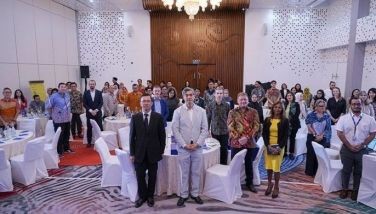‘No Country’: A travelogue of sorts
It will give you a case of mind-melt: the man takes a photograph (an act of recording light) of people shining back strobes of light. Through round mirrors. Light within light. An artful counter-act.
This is the brilliant work of Poklong Anading, one of two Filipino artists (the other one being Norberto Roldan) currently exhibited at “No Country: Contemporary Art for South and Southeast Asia†on view until July 20 at The Centre for Contemporary Art (CCA) in Singapore.
Here are the artist’s words behind the images: “Most of the people in the photograph are gallery-goers. I shot this at the University of the Philippines (UP) Sunken Garden, lunchtime. Nanghiram lang ako ng camera para dito (I borrowed a camera for this piece). This is the start of the idea for my ‘Anonymous’ series.’ It’s about the response of the subject (to the taking of the photo). In a way, it is a sharing of the experience. I like the idea of the subject (himself or herself) accomplishing, completing the work.â€
Curators would characterize Poklong’s piece as a subversion of “the photographic gesture as light,†while “the act of looking are both doubled and foiled.†It can be a magnet for doublethink (but not in the way intended by George Orwell in Nineteen Eighty-Four). Viewers are going to double-back and think twice about the Poklong piece on view.
Anading is an easygoing fellow. (He lives in a compound in Cubao that also is the site of the studios of artist-friends like Louie Cordero and Gary-Ross Pastrana; Lourd De Veyra pops in from time to time bearing spirits.) Poklong’s conceptual work is much respected not just in Manila but elsewhere around the world. Let me show you a glimpse of how the man’s mind works: in a remarkable exhibit years ago at Mag:net Katipunan, the artist collected stones from road construction project, ingeniously calling it “Fallen Map.†He admits that he values curatorial interpretation, or even the opinion of casual observers of his art.
“’Yun ang mahalaga (that’s what’s important) — ’yung response ng ibang tao sa artworks ko (the response of other people to my artworks). They give my art a different dimension, a whole new meaning.â€
June Yap, Guggenheim UBS MAP curator for South and Southeast Asia, points out the work is about illumination and yet, at the same time, the faces of the subjects are obscured. Thus, she adds, you seek to understand the artwork through the shadows travelling through the light.
There is a point in “peeling off†shadows in contemporary art, much light will be revealed, a harvest of epiphanies brought forth.
The CCA Singapore recently invited The Philippine STAR for an exclusive preview of the exhibition that is part of the Guggenheim UBS Global Art Initiative, a multi-year collaboration that charts contemporary art practice in three geographic regions — South and Southeast Asia, Latin America, and the Middle East and North Africa — and encompasses curatorial residencies, international touring exhibitions, audience-driven education programming, and acquisitions for the Guggenheim’s permanent collection.
The exhibition features the works of Bani Abidi (Pakistan), Reza Afisina (Indonesia), Poklong Anading (The Philippines), Sheela Gowda (India), Shilpa Gupta (India), Amar Kanwar (India), Vincent Leong (Malaysia), Tayeba Begum Lipi (Bangladesh), Tuan Andrew Nguyen (Vietnam), The Otolith Group (United Kingdom), Sopheap Pich (Cambodia), Navin Rawanchaikul (Thailand), Norberto Roldan (Philippines), Arin Dwihartanto Sunaryo (Indonesia), Tang Da Wu (Singapore) and Tran Luong (Vietnam).
According to June Yap, “No Country†— a phrase taken from W.B. Yeats’ immortal “Sailing to Byzantium†— is an exhibition about the sense of belonging borne out of experiences of biography and history, which is inevitably layered upon physical geography.
There is something reductive about rendering cultures to bite-size categories and formulas. “Uniqueness and exclusivity defined by nations†fail to reflect people’s actual experiences and overlook the complexities of “dialogue, assimilation and resistance across real and imagined boundaries.â€
The works featured dutifully amplify the theme.
In Tuan Andrew Nguyen’s “Enemy’s Enemy: A Monument to a Monument,†a classic American baseball bat (a Louisville Slugger) is transformed into a sculptural relief portraying the figure of ThÃch Quảng Äúc, a venerated Buddhist monk who performed self-immolation in 1963. Sports, religion and American imperialism — the informed viewer will appreciate the layers of meaning in this particular piece, an artistic homer for the Vietnamese artist.
Tayeba Begum Lipi’s “Love Bed†is an ironically named sculpture: it is a bed composed of blades. An emblem of rest that turns into something that poses bodily, bloodily harm.
Sopheap Pich from Cambodia studied Western art in the States, but upon his return to his native country, rather than pursuing painting, Pich instead turned to indigenous materials such as rattan and bamboo to fashion his spectacular sculptures. His “Morning Glory†is a monumental depiction of the flower, which — as remembered by the artist — was a critical source of nourishment for ordinary Cambodians during the difficult period of the Khmer Rouge.
“If I were to encapsulate ‘No Country’ in one word, it is… representation,†she explains. “Of how we project, absorb, perceive, believe, desire, defend, and redefine, who we are. ‘No Country’ proposes the reevaluation of the region and its countries, through cultural relationships, influences, affinities, and negotiations. In the reflections of the 16 artists at CCA, we find the possibility of considering, and perhaps recalibrating, our understanding of our communities and our cultures, as greater than their political and geographic boundaries. And in so doing these artworks reinstate art practice as political life, as cultural negotiation rather than representation, and not merely the consequence of a past, but portents for a future.â€
As a summation, “No Country†is an exploration of intertwined pasts that produce the present, of relations and frictions that challenge prescriptive and simple definitions of the region. The title foregrounds the paradox of nation, in order to examine the conceptualization, formulation and construction of community.
Going around the exhibition at the CCA, one will probably arrive at the conclusion that the “No Country†phrases can also entail going “beyond country,†of transcending borders and not being solely defined by domicile and circumstance.
Contemporary art, after all, hails from a certain locale but is a rover. A wanderer, nomad, vagabond, call it what you will — to echo the words of Metallica. It loves being exiled from the mainstream.



















